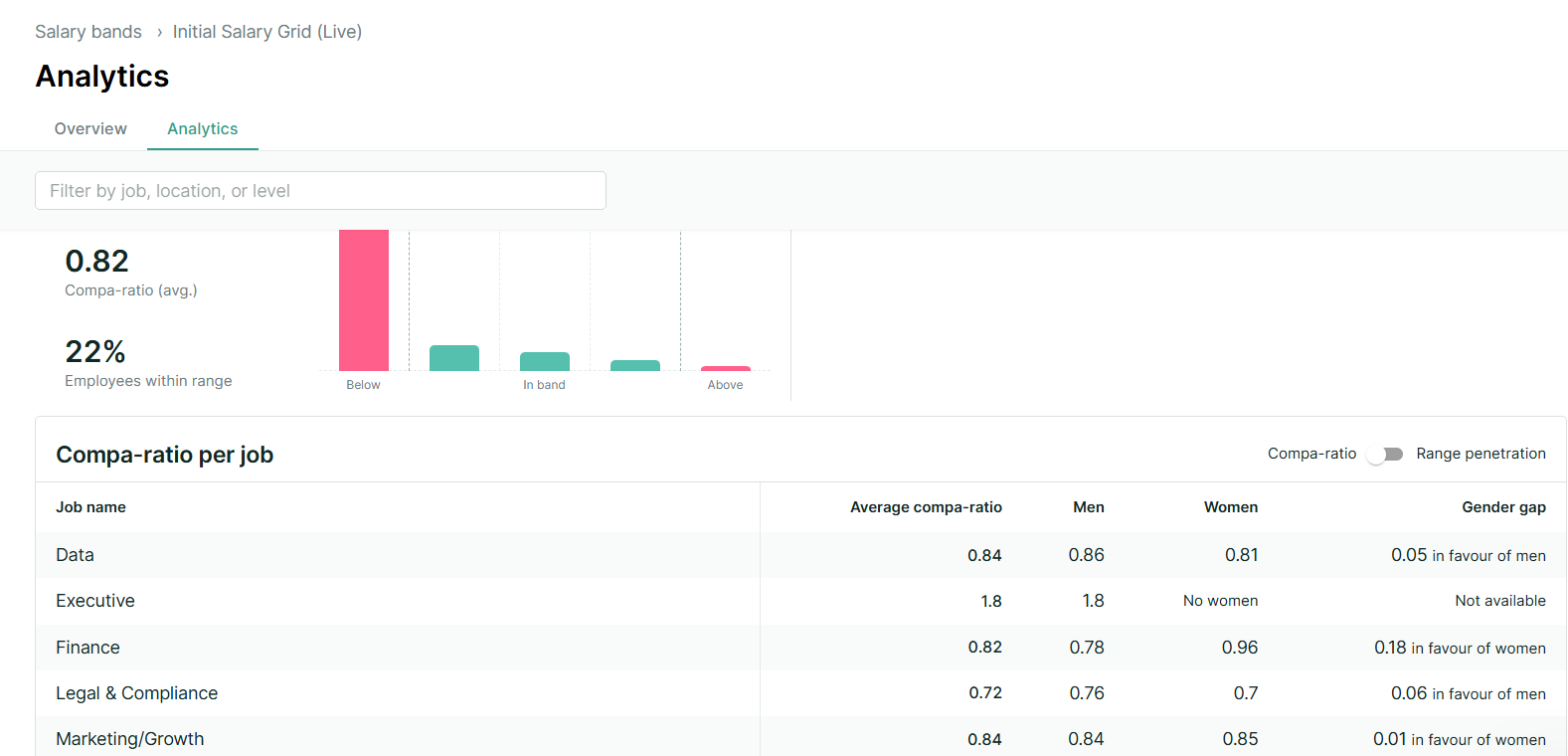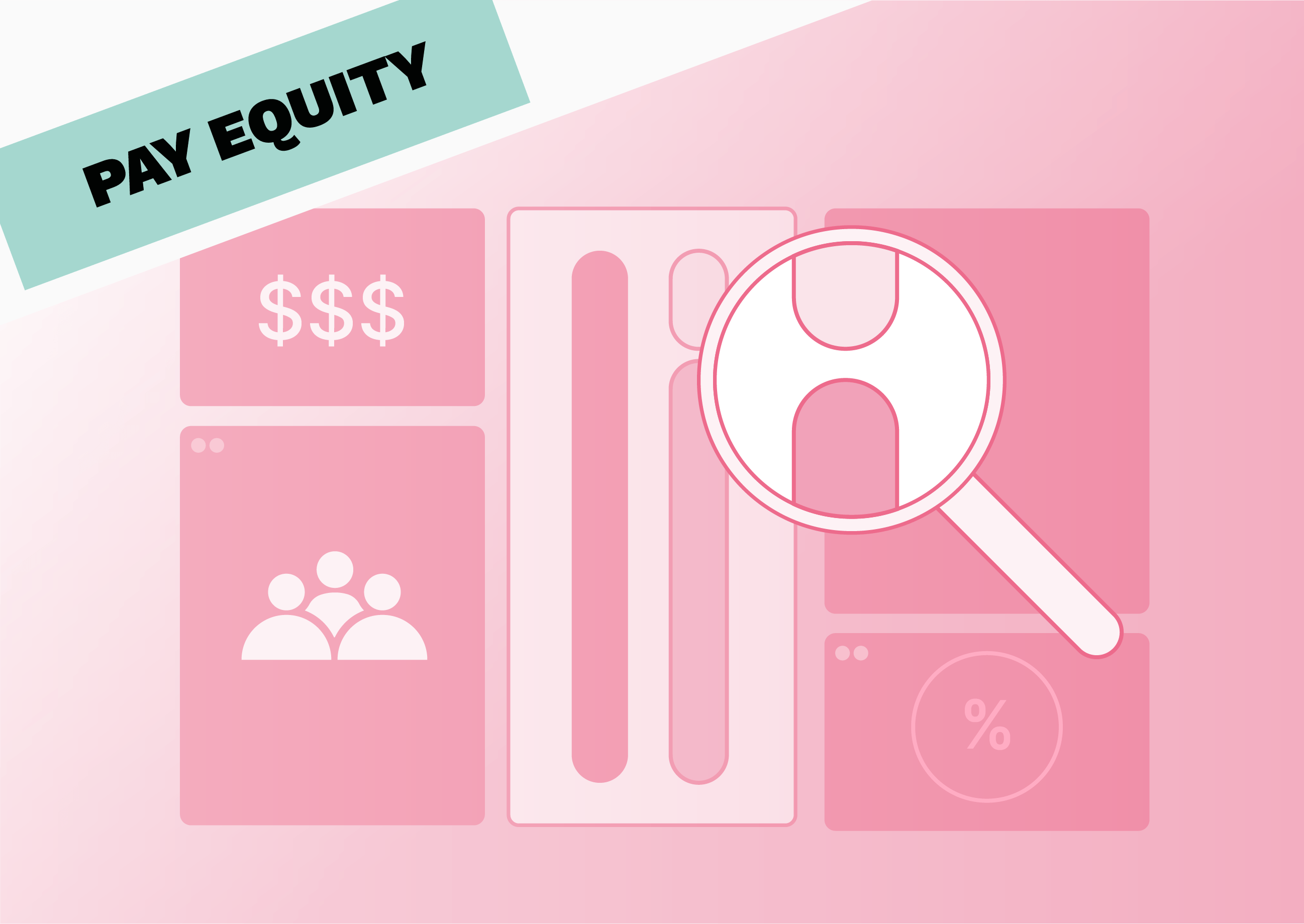Key points:
- Systemic undervaluation creates hidden pay gaps: Workplace evaluation systems consistently devalue certain job families through biased review criteria, forced ranking, and performance metrics that reward visible outputs over preventative work.
- Historical bias still shapes modern pay: Occupational feminisation means that when jobs become predominantly associated with women, average pay drops – even when the work remains unchanged.
- The business impact is measurable: when employees feel undervalued, they are more likely to quit. On the other hand, those who are paid fairly are more likely to report higher productivity.
- Compliance pressure is coming: The EU Pay Transparency Directive (June 2026) requires reporting by job family and assessing "work of equal value." Companies with unjustified pay gaps above 5% face mandatory joint assessments with employee representatives.
- Data makes the invisible visible: Real-time pay equity analysis replaces outdated surveys with monthly benchmarks, helping you identify gaps across job families, investigate root causes, and close disparities with confidence before regulatory deadlines hit.
Your customer support team works flat out, preventing churn and solving complex problems. All while dealing with complicated customers day in, day out… yet they're consistently paid less than sales colleagues with similar tenure. Sound familiar?
What you're witnessing here is systemic undervaluation. It’s a culture embedded in your company's evaluation systems that creates frustrating and unfair pay discrepancies across job families. It’s likely affecting your employees right now.
Perkbox research found that 42% of employees reported feeling undervalued in their current role. Pippa Van Praagh, Vice President of Operations at Perkbox, recently warned that "the UK is on the brink of a workplace value exodus."
Unfortunately, that means you’ve got to pull your socks up, because the problem isn’t going to solve itself. Don’t worry – we here at Figures will provide you with helpful advice to close those gaps. It is our bread and butter after all.
We'll break down what systemic undervaluation actually is, trace where it comes from, show you the damage it's causing your business, and give you practical steps to start fixing it.
What is systemic undervaluation in the workplace?
Systemic undervaluation is the consistent devaluation of certain roles through workplace evaluation systems that discount contributions regardless of their actual impact.
Here's how to spot it in your company:
- Pay band disparities by department: check whether HR, Customer Support, or Operations consistently sit at the lower end of your pay scales while Engineering or Sales occupy the higher bands. If this pattern holds even when comparing similar levels of experience and responsibility, you could be looking at systematic undervaluation.
- "Acting up" without recognition: employees cover senior duties, manage projects beyond their remit, or step into leadership gaps. But their title and compensation remain frozen.
- The office housework problem: certain teams spend hours on meeting coordination, documentation, onboarding support, and admin tasks that keep everything running, rather than working toward promotable projects.
- Tokenism masking structural issues: your company promotes one person from an undervalued group and treats it as proof that the system works. Meanwhile, the pay bands, progression criteria, and evaluation methods for their entire job family remain unchanged.
Keep in mind, most companies don’t just have one symptom of this illness. They likely have different mixes, suggesting that systemic undervaluation is a cultural issue. And just like gender pay gaps, the roots of this undervaluation can run deep.
The roots of undervaluation: Why certain jobs pay less
Your pay structures didn't appear from nowhere. They carry forward decades of societal bias, imported into modern compensation frameworks through job evaluation methods, market benchmarking, and inherited assumptions about what counts as "valuable work."
The good news is, understanding where these structures came from will help you dismantle them. After all, you’d be a pretty terrible gardener if you cut the stems off weeds, but never looked for the roots. It’s the same principle in HR... albeit a fair bit more complicated.
Historical hangovers
Let’s look at history first.
The answer lies in occupational segregation and occupational feminisation – the well-documented phenomenon where pay for an entire field stagnates or falls as it becomes predominantly associated with women.
Research from the London School of Economics shows that when occupations feminise, average pay tends to drop, even when the work itself remains unchanged. Think of job roles around administrative and support roles, which historically weren’t considered valuable skills that deserved recognition or compensation.
Well, those attitudes don’t really disappear, even with the rise of feminism. They just become insidiously buried in company culture and allowed to fester for years.
And because these undervalued job families remain disproportionately staffed by women, people of colour, and disabled employees, the systemic issue of undervaluing the work creates significant and measurable pay gaps for these demographic groups.
Organisational blind spots
Moving on from the harmful historical attitudes that are still perpetuated today, let’s take a look at blind spots.
Truth is, most companies don't set out to perpetuate bias. They instead import historical undervaluation through seemingly neutral processes that never get questioned.
Granted, if companies were a little more honest and introspective on their processes, these blind spots wouldn’t exist. So the excuse of “we didn’t know” won’t fly here. That’s how systemic discrimination is allowed to exist.
Speaking of, let’s look at some examples:
- Outdated job evaluation methods: systems award points for "physical effort" whilst ignoring emotional labour, mental load, or problem-prevention work. This skews value towards traditionally male roles and discounts expertise in care, coordination, and customer-facing positions.
- The "market rate" trap: paying market rate sounds responsible. In reality, you're importing other companies' biases into your structure. It’s like copying the kid next to you in a test… only to realise they’re thick as paint and every answer is wrong.
- Siloed compensation planning: departments set budgets independently, without comparing whether a Head of Customer Success brings equivalent value as a Head of Product. Revenue generation gets prioritised over revenue protection, visible outputs over invisible problem-prevention.
"Without a conscious effort to challenge our assumptions, we risk building modern companies on top of very outdated ideas about what 'valuable work' looks like," explains Virgile Raingeard, CEO at Figures.
So, never accept the excuse of a blind spot. It’s a hollow excuse, and an admission that those with power to change things were asleep at the wheel.
The real cost of undervaluation to your business
Guess what? As an HR rep, you’re judged by all of this, even though you didn’t invent these structures (at least you better not have, otherwise we’re telling!!!). That’s because undervaluation can have a real impact on business practices, which will be on your head, because your managers and CEOs will wonder why you never noticed anything wrong…
So, what are the impacts?
- Increased staff turnover: when employees feel their entire profession is undervalued, they don't just leave their manager; they leave the company. 34% of employees have considered quitting because they felt undervalued.
- Damaged productivity and morale: feeling undervalued is a powerful demotivator. Research shows 81% of workers feel more productive and loyal when they believe they're paid fairly. The inverse is equally true: undervalued employees disengage, do the minimum, and take their expertise elsewhere.
- A barrier to talent attraction: your reputation precedes you. When certain job families consistently report pay dissatisfaction or lack of progression, word spreads. Candidates research companies before applying – and they talk to current employees. Undervaluation becomes a recruitment liability.
- Upcoming compliance nightmares: the EU Pay Transparency Directive arrives in June 2026. If you report an average pay gap of 5% or more that can't be justified, you'll face a joint pay assessment with employee representatives.
Speaking of the EU requirements, have a look at the table below for a more comprehensive breakdown.
Ignoring systemic undervaluation now means addressing it under regulatory pressure later, with employees and representatives watching every move.
🤔 If you’ve only got offices in the UK, it’s still in your best interests to follow the EU’s example. Sure, Brexit may have allowed you to cut ties with EU regulations, but considering how undervaluation can affect your business, focusing on better pay equity is only going to benefit you.
Breaking the cycle: how to build a culture of fair value
Systemic undervaluation won't fix itself. You need a deliberate strategy and culture change to dismantle these patterns. Here's your practical roadmap.
1. Conduct a "Work of Equal Value" Audit
Go beyond comparing like-for-like roles. Start comparing different job families based on skill, effort, and responsibility. Does your Head of Customer Success require comparable expertise to your Head of Product? Then their compensation bands should reflect that.
Look for red flags: unstructured review criteria, forced ranking systems, or performance metrics that reward visible outputs (bugs found) over preventative work (defects prevented).
Why does this matter? Because employees notice these issues before you do. Research shows that 4 out of 5 of the top responses relate to fair compensation when workers are asked what they value most at work. If your systems can't measure value fairly, you're already losing trust.
‼️Sort your job architecture first! Proper role and responsibility identification can help you identify pay disparities more accurately.
2. Champion holistic recognition programmes
Fair pay is the foundation, but a culture of value is the building. Deloitte research shows organisations with strong recognition programmes have a 31% lower voluntary turnover rate. Keep in mind, recognition doesn’t mean patting your lead dev on the head for a job well done (though that’s good, too). It’s better pay and promotion opportunities.
3. Improve communication and transparency
Over two-thirds (69%) of UK workers suspect that pay secrecy is directly fuelling inequality in their workplace. They're right to be suspicious.
Leaders should create an environment where all employees feel safe to speak up and are included in decisions that affect them. Transparency doesn't mean publishing everyone's salary.
‼️Keep in mind, it’s illegal to enforce pay secrecy in the UK. If you are preventing discussions… well, you’ve obviously got some skeletons in your closet.
4. Broaden your definition of "compensation"
Total compensation is more than salary. Offering genuine flexible working can be a high-impact way to demonstrate value, particularly for roles that have been historically undervalued. Over half of UK professionals (52%) cite flexible working as their most desired benefit.
5. Redesign your performance systems for fairness
Move towards systems that recognise actual value. This means implementing structured review criteria, using 360-degree feedback to capture wider impact, and ensuring DEI oversight during calibration meetings to challenge biases. If your current system consistently produces lower ratings for certain job families, the system has failed, not the people.
Tackling workplace undervaluation with data
Building a culture of fair value is the goal, but you can't fix what you can't see. Without robust data, you risk relying on outdated salary surveys. And when the market is moving at the speed of sound, you can’t be relying on antiquated surveys. Screw the pencil-pushing, opt for something better with nice, shiny dashboards.
Figures' Pay Equity solution was designed to replace stale data with real-time clarity. We help you see your entire organisation through a lens of fairness, based on monthly updated benchmarks.
Key benefits:
- See the full picture: Dashboards provide visual breakdowns of pay disparities, highlighting gaps between job families, not just genders (though we do that too!!!).

- Pinpoint the root cause: Drill down to identify specific employees or roles with potential pay gaps, so you can investigate the 'why' behind the numbers.

- Close gaps with confidence: Get clear, data-driven recommendations to correct unfair discrepancies and use objective evidence to justify legitimate differences in pay.
- Get ahead of compliance: The EU Pay Transparency Directive requires reporting by job family and assessing "work of equal value." 82% of companies that join Figures have pay gaps that would be too high for the 2026 regulations.
"Data tells a story. Our goal is to give every HR leader the tools to read that story, understand it, and then rewrite the ending to be a fairer one for everyone in their company," explains Agnès Chauvigny, VP People at Figures.
It's time to make fair pay your reality
Systemic undervaluation is a real, costly problem inherited from historical biases, but it doesn't have to define your company's future.
Addressing it isn't about ticking a compliance box. It's a strategic move to improve retention, boost productivity, and strengthen your employer brand. The companies that act now will lead with fairness. Plus, fairer companies will get first pick of the talent running from companies that undervalue their work.
Moving from intuition to data-driven insights is the only way to build a truly equitable workplace. You need visibility into how your evaluation systems actually function, not how you assume they work.
Book a free demo and discover how Figures helps UK and European HR leaders turn compensation data into a competitive advantage… before regulatory pressure forces your hand. Be one of the cool companies – get ahead of the curve!
Summarize this article with AI
No time to read it all? Get a clear, structured, and actionable summary in one click.






